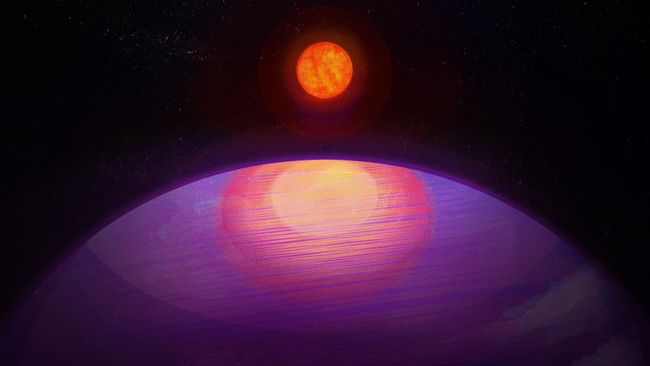Welcome to DU!
The truly grassroots left-of-center political community where regular people, not algorithms, drive the discussions and set the standards.
Join the community:
Create a free account
Support DU (and get rid of ads!):
Become a Star Member
Latest Breaking News
Editorials & Other Articles
General Discussion
The DU Lounge
All Forums
Issue Forums
Culture Forums
Alliance Forums
Region Forums
Support Forums
Help & Search
Science
Related: About this forumThis 'forbidden' exoplanet is way too massive for its star
By Robert Lea published about 10 hours ago
"This discovery really drives home the point of just how little we know about the universe. We wouldn’t expect a planet this heavy around such a low-mass star to exist."

the top half of a large purple orb raises from the bottom like an eye peering upward, its diameter spanning the bottom of the image, near its top, lighter purple in the shape of an eye, with a red/orange iris and yellow pupil. a small orange/yellow sun hangs above in the center. Illustration shows a massive planet in orbit around a diminutive star.
Illustration shows a massive planet in orbit around a diminutive star. (Image credit: Penn State)
Astronomers have discovered a massive extrasolar planet, or "exoplanet," orbiting an ultracool dwarf star that is way too small to host such a world, challenging scientists' models of how planets and planetary systems are born.
The planet in question, designated LHS 3154 b, is 13 times as massive as Earth, meaning that it has a mass similar to the solar system ice giant Neptune, yet it closely orbits a tiny dwarf star, which is nine times less massive than the sun.
This means the ratio between the Neptune-like world and its parent star — LHS 3154, which is located around 51 light-years away — is 100 times greater than the mass ratio between Earth and the sun, something researchers didn’t think was possible. This is the first time a planet with such a great mass has been found around one of the universe’s more diminutive stars.
"This discovery really drives home the point of just how little we know about the universe," research co-author and Penn State University Verne M. Willaman Professor of Astronomy and Astrophysics, Suvrath Mahadevan, said in a statement. "We wouldn’t expect a planet this heavy around such a low-mass star to exist."
More:
https://www.space.com/exoplanet-massive-hpf-star-habitable-zone-planetary-models
InfoView thread info, including edit history
TrashPut this thread in your Trash Can (My DU » Trash Can)
BookmarkAdd this thread to your Bookmarks (My DU » Bookmarks)
3 replies, 559 views
ShareGet links to this post and/or share on social media
AlertAlert this post for a rule violation
PowersThere are no powers you can use on this post
EditCannot edit other people's posts
ReplyReply to this post
EditCannot edit other people's posts
Rec (7)
ReplyReply to this post
3 replies
 = new reply since forum marked as read
Highlight:
NoneDon't highlight anything
5 newestHighlight 5 most recent replies
= new reply since forum marked as read
Highlight:
NoneDon't highlight anything
5 newestHighlight 5 most recent replies
This 'forbidden' exoplanet is way too massive for its star (Original Post)
Judi Lynn
Dec 2023
OP
Permanut
(6,638 posts)1. The universe is full of surprises..
Mind boggling discoveries, seems like every week. Great post, Judi Lynn; your posts always make me think of Carl Sagan.
"Billions and billions"
GreenWave
(9,179 posts)2. What we only know is a small picture right now.
Consider our "yellow" dwarf. How can it hold so many objects in its solar system now estimated to be 3 and one half light years across? Some conjecture is that our sun has a burnt out dwarf companion star in an exotic orbit enabling the system to "keep it together".
2naSalit
(92,695 posts)3. The one constant, so far...
In our discoveries of our universe is we learn that we really don't know a lot.